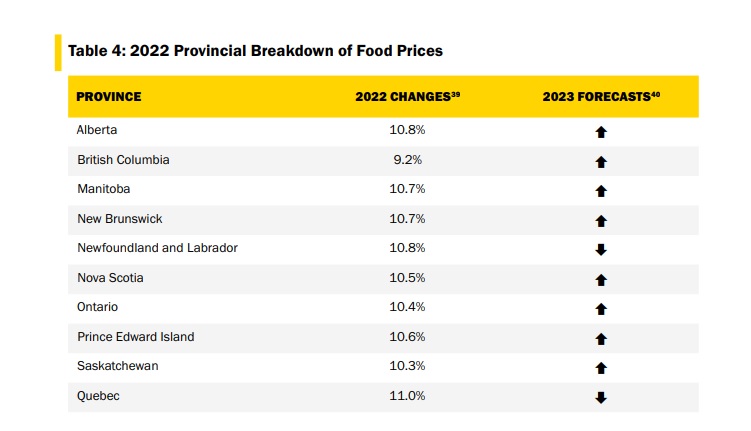According to Canada’s Food Price Report for 2023, Alberta was among the top three provinces that saw the highest food inflation in the country. Alberta saw a 10.8 per cent increase in 2022 when it came to an increase in food prices. The only province that had a higher increase was Quebec at 11 per cent.
 As a province, Alberta saw some of the highest increases in food prices across the country. (Photo provided by Canada Food Report 2023)
As a province, Alberta saw some of the highest increases in food prices across the country. (Photo provided by Canada Food Report 2023)The report is also forecasting that in 2023, consumers will not feel any relief when paying for groceries.
"It is expected that Canadians will continue to feel the effects of high food inflation, and food insecurity/affordability will also be a big issue with rising food prices. The effects of climate change and the impact of high transportation costs, as a result of higher oil prices, will also continue through next year," an excerpt from the report stated.
The report also illustrated that in comparing forecast foodstuff cost increases for 2022 and the actual change in prices, there was a significant increase. Bakery items saw the highest rise in cost, a nearly 15 per cent increase.
 A chart from the 2023 Canada Food Report shows that there was a significant difference between forecasted inflation for 2022 and the reality of what consumers were paying. (Photo provided by Canada Food Report 2023)
A chart from the 2023 Canada Food Report shows that there was a significant difference between forecasted inflation for 2022 and the reality of what consumers were paying. (Photo provided by Canada Food Report 2023)The report stated that because most of the country and globe is still dealing with the havoc that the COVID-19 pandemic caused, supply chain issues and labour shortages compounded the problems.
The trends Albertans and Canadians are seeing at the store shelves when it comes to increased costs will continue into 2023. The report predicts that overall, prices for all food categories could increase by up to 7 per cent in 2023. Produce may increase anywhere from 6 per cent to 8 per cent.
"Overall, commodities prices are increasing, and the global supply chain has been impacted by multiple factors including an unprecedented price increase for numerous commodities and food products. Some of these increases include the cost of crop inputs (i.e., fuel, chemicals, and fertilizers) which have increased by 50 per cent or more."
The report suggests that a family of four comprised of a man (age 31–50), woman (age 31–50), boy (age 14–18), and girl (age 9–13), the annual food expenditure is predicted to be up to $16,222.80 in 2023.
 This table from the Canada Food Report 2023 provides examples of different household compositions and their predicted annual food expenditure for 2023. (Photo provided by Canada Food Report 2023)
This table from the Canada Food Report 2023 provides examples of different household compositions and their predicted annual food expenditure for 2023. (Photo provided by Canada Food Report 2023)"This is an increase of up to $1065.60 from the observed annual expenditure for a family of the same demographic makeup in 2022."
With the skyrocketing grocery prices, the report stated that food affordability has been a significant issue and topic of conversation among many households, with many consumers attempting to try and save money by using a variety of methods including reading weekly flyers, using coupons, and taking advantage of volume discounting, and using food rescuing apps.
The report also stated that according to the 2022 HungerCount published by Food Banks Canada, use of food banks has increased in Canada by 15 per cent and that number is expected to grow in the coming year.
"Food security will continue to be a concern for many in 2023 as the price of food is expected to increase," the report concluded.
Send your news tips, story ideas, pictures, and videos to news@discoverairdrie.com





